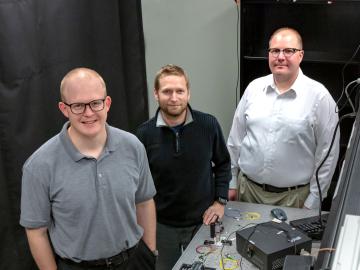
Filter News
Area of Research
- (-) Energy Science (40)
- (-) Supercomputing (60)
- Advanced Manufacturing (4)
- Biology and Environment (31)
- Computational Engineering (1)
- Computer Science (9)
- Electricity and Smart Grid (2)
- Energy Frontier Research Centers (1)
- Functional Materials for Energy (1)
- Fusion and Fission (2)
- Materials (54)
- Materials for Computing (10)
- National Security (16)
- Neutron Science (18)
- Quantum information Science (9)
News Topics
- (-) Big Data (27)
- (-) Composites (17)
- (-) Machine Learning (20)
- (-) Mercury (3)
- (-) Microelectronics (1)
- (-) Nanotechnology (15)
- (-) Quantum Science (26)
- 3-D Printing/Advanced Manufacturing (81)
- Advanced Reactors (7)
- Artificial Intelligence (42)
- Bioenergy (29)
- Biology (19)
- Biomedical (22)
- Biotechnology (6)
- Buildings (39)
- Chemical Sciences (16)
- Clean Water (8)
- Computer Science (108)
- Coronavirus (25)
- Critical Materials (12)
- Cybersecurity (14)
- Energy Storage (74)
- Environment (69)
- Exascale Computing (27)
- Fossil Energy (2)
- Frontier (32)
- Fusion (2)
- Grid (41)
- High-Performance Computing (44)
- Hydropower (3)
- Isotopes (2)
- Materials (45)
- Materials Science (40)
- Mathematics (4)
- Microscopy (14)
- Molten Salt (1)
- National Security (11)
- Neutron Science (20)
- Nuclear Energy (11)
- Partnerships (12)
- Physics (8)
- Polymers (13)
- Quantum Computing (20)
- Security (10)
- Simulation (18)
- Software (1)
- Space Exploration (6)
- Statistics (1)
- Summit (44)
- Transportation (70)
Media Contacts

In collaboration with the Department of Veterans Affairs, a team at Oak Ridge National Laboratory has expanded a VA-developed predictive computing model to identify veterans at risk of suicide and sped it up to run 300 times faster, a gain that could profoundly affect the VA’s ability to reach susceptible veterans quickly.

A team including Oak Ridge National Laboratory and University of Tennessee researchers demonstrated a novel 3D printing approach called Z-pinning that can increase the material’s strength and toughness by more than three and a half times compared to conventional additive manufacturing processes.

More than 6,000 veterans died by suicide in 2016, and from 2005 to 2016, the rate of veteran suicides in the United States increased by more than 25 percent.

IDEMIA Identity & Security USA has licensed an advanced optical array developed at Oak Ridge National Laboratory. The portable technology can be used to help identify individuals in challenging outdoor conditions.

Using the Titan supercomputer at Oak Ridge National Laboratory, a team of astrophysicists created a set of galactic wind simulations of the highest resolution ever performed. The simulations will allow researchers to gather and interpret more accurate, detailed data that elucidates how galactic winds affect the formation and evolution of galaxies.

A new method developed at Oak Ridge National Laboratory improves the energy efficiency of a desalination process known as solar-thermal evaporation.

Sometimes solutions to the biggest problems can be found in the smallest details. The work of biochemist Alex Johs at Oak Ridge National Laboratory bears this out, as he focuses on understanding protein structures and molecular interactions to resolve complex global problems like the spread of mercury pollution in waterways and the food supply.

OAK RIDGE, Tenn., May 7, 2019—Energy Secretary Rick Perry, Congressman Chuck Fleischmann and lab officials today broke ground on a multipurpose research facility that will provide state-of-the-art laboratory space
OAK RIDGE, Tenn., Feb. 12, 2019—A team of researchers from the Department of Energy’s Oak Ridge and Los Alamos National Laboratories has partnered with EPB, a Chattanooga utility and telecommunications company, to demonstrate the effectiveness of metro-scale quantum key distribution (QKD).

By analyzing a pattern formed by the intersection of two beams of light, researchers can capture elusive details regarding the behavior of mysterious phenomena such as gravitational waves. Creating and precisely measuring these interference patterns would not be possible without instruments called interferometers.


